This is my first attempt at a bilingual posting, which explores the 2021 census and 2023 local elections to analyse whether there is a close connection between religion and identity. (Easy subject material: I know you know the answers already!) I haven’t written publicly in Irish before. I don’t have a degree in Irish, so my text will have mistakes (apologies in advance; but do post to let me know). I have written this in Irish first.
I am not trying to make any point regarding the superiority of Irish over English. They are both languages for communication, and both are equally agile in grappling with the complexity of the modern world.
I wish I had enough Ulster-Scots to write in that language. The more languages and words we have at our disposal, the more fun and creativity we can have communicating with each other.
I hated Irish at school down South, but became interested in it while teaching in eastern Ghana when learning Ewe, the local language. My interest was deepened by attending classes in the Linenhall Library in 1991, the vast majority of my classmates being Protestant and British. Languages do not attend a church or vote. It is up to us to live lives nourished by the cultural treasures from all groupings of people who have come to this island. Nobody spoke Irish when the island was covered by ice 10,000 years ago. We are all descended from migrants.
—————-
An t-athrú pholaitiúil is suntasaí a tharla i dTuisceart Éireann (TÉ) ó 1998 ná méadú an céatadán de vóta Pháirtí Comhghuaillíochta Thuaisceart Éireann (PCTÉ). I 2003, níor bhain an PCTÉ amach ach 3.7% den vóta. Léim an-mhór i 2019 agus 16.8% faighte acu. Meath beag ó shin go 15.0% i mbliana. Ar thig linn a rá go bhfuil an dul chun cinn seo réabhlóideach? An bhfuil deireadh an ré thart faoi ceangal plúchtach idir reiligiún agus féiniúlacht pholaitíochta?
The most significant political change that occurred in Northern Ireland since the signing of the Belfast Good Friday Agreement is arguably the rise in the vote share of the Alliance Party. Alliance gained only 3.7% of the valid poll in 2003. By 2019 a big jump had occurred, to 16.8%. This declined slightly to 15.0% this year. Is this progress revolutionary? Is it the end of the road for the suffocating link between religion and political identity?
Fan nóiméad! Dár liom, is é bogadh reiligiún an bogadh is mó a dhéanann duine ag imeacht ó heaglais go dtí ‘gan chreideamh’. Má fhanann daoine ina gCaitliceach nó ina bProtastúnach, tá seans millteanach mór go votálaíonn said le páirtí aontachtach nó páirtí náisiúntacht (grafanna a 1 agus a 2). Ní féidir é sin a rá go furasta maidir leis an lucht gan chreideamh.
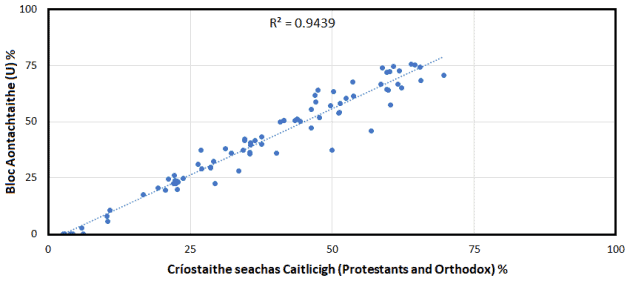
Not so fast! It seems to me that the biggest change a person will make is to move from being a member of one church to becoming a non-believer or non-adherent. If voters stay in their natal religion, they are extremely likely to vote for unionist or nationalist parties (graphs 1 and 2). That can not be said for the non-believers to the same extent.
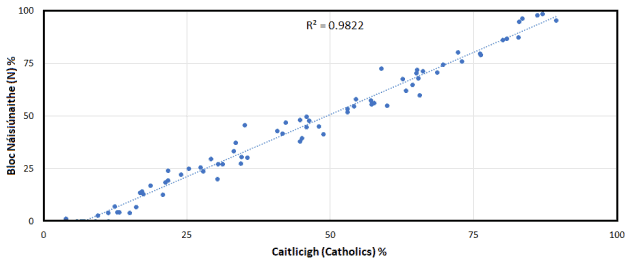

Cá bhfuair mé na huimhreacha atá anseo? Bhuel, is féidir leat na figiúirí reiligiúnacha ón Áireamh 2021 a fháil anseo (íoslódáil an zipchomhad ‘Part 1’, agus féach ar an scarbhileog “census-2021-ms-b19.xlsx”). Tá na figiúirí curtha i láthair do gach barda (482 barda). Is rud éasca iad a bhailiú sna 80 toghcheantar a húsáideadh sna toghcháin áitiúla i 2023. Tá na torthaí sin le fail ar suíomhanna na 11 comhairle ceantair. Caithfear a rá go bhfuil na figiúirí reiligiúnacha dírithe ar gach aois, a mhalairt ar na figiúirí thoghchánacha. Mar sin, bíodh písín salainn agat agus tú ag léamh an t-alt seo. D’ainneoin sin, feicimid patrúin shoiléire idir phoilitíocht agus religiún. Ta ochtú pointe i ngach graf: pointe amháin le gach toghcheantar.
Religious data for this piece was sourced from the 2021 census (download the ‘Part 1’ zipfile and look at the “census-2021-ms-b19.xlsx” spreadsheet). Religion figures are presented for each electoral ward, all 482 of them. It is a simple matter to add the figures for the relevant wards to get the religion data for the 80 electoral areas (EAs) that were the basis of the 2023 local elections. The results can be found on the websites of the 11 district councils. The religion data are for all ages of the population, in contrast to the adults-only electorate, so my graphs should, perhaps, be taken with a pinch of salt. Nevertheless, they do show clear patterns between religious background and electoral behaviour. All graphs have 80 data points, one for each EA.
Tá luach R2 (nó R-chearnach) i ngach graf. Cad é seo? Is é tomhas chomhchoibhneas an luach R-chearnach idir dhá athróg. Bíonn an luach R-chearnach 1 ma bhíonn comhchoibhneas foirfe (mar shampla: má bhíonn tú beo bíonn tú ag análú). Muna bhíonn aon comhchoibhneas ar bith bíonn an luach R-chearnach 0 (m.sh.: dath shúile agus airde, sílim).
Each graph has an R2 (or R-squared) value. What is this? The R-squared value is a measure of how well two variables correlate to each other. If the R-squared value is 1, there is a perfect correlation (e.g. all living people can breathe). If there is no correlation (e.g. eye colour and height), then the R-squared value is 0.
Tá dlúthcheangal reiligiún agus féiniúlacht is airde – beagnach foirfe – le náisiúnachas agus Caitleaceachas (0.98), agus tá aontachtas agus Protastúnachas díreach laistiar le 0.94. Ach, níl an ceangal chomh láidir (0.76) leis na daoine eile (na ‘hOthers’) agus líon na reiligiúin Neamh-Chríostaí curtha leis na daoine nár dhúirt agus líon na haindiachaithe (graf a 3).
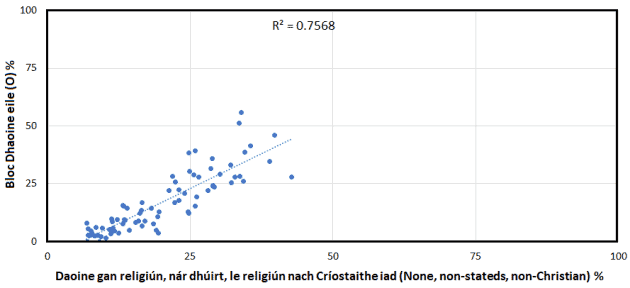

The highest religion-political identity correlation – almost perfect – is between nationalism and Catholicism (0.98). Unionist-Protestant correlation is snapping at its heels with a 0.94 R-squared figure. However, the link between Other voters and non-Christians (adding the ‘nones’, ‘not stateds’ and adherents of non-Christian religions) is still strong, though less so, with an R-squared value of 0.76 (graph 3).
Céard faoi na ceangail náisiúnachas-Protastúnachas (graf a 4) agus aontachtas-Caitleachas (graf a 5)? Frith-chomhchoibhneas beagnach foirfe atá i gceist anseo: má bhíon céatadán mór Chaitlicigh i dtoghcheantar bíonn céatadán beag aontachtaithe, agus a mhalairt. Agus feictear céatadán beag náisiúnaithe má bhíonn céatadán mór Protastúnaithe sa thoghcheantar, agus a mhalairt.
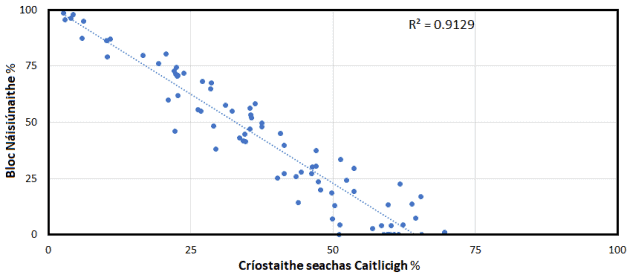

What of the nationalist-Protestant (graph 4) and unionist-Catholic (graph 5) correlations? Almost perfect anti-correlations are what we see. The higher the Catholic % of the population of an EA, the smaller the unionist vote; and vice-versa. An EA with a low Protestant % of the population will have a high nationalist vote, and vice-versa.
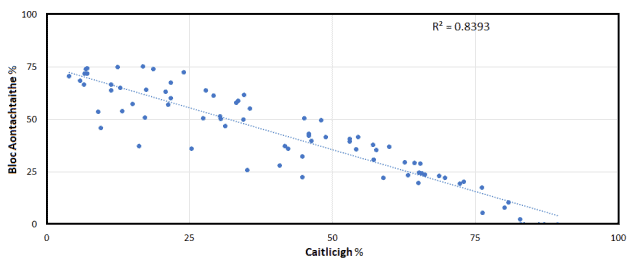

Tá turas fada i ndán dúinn sula mbrisfear an nasc idir reiligiún agus polaitíocht sa Thuaisceart.
There’s a long way to go in the North before the link between religion and politics is broken.
Philip McGuinness taught at Dundalk Institute of Technology, plays mandolin with the Oriel Traditional Orchestra and loves to walk around and over the wee perfect hills of the Ring Of Gullion.
Discover more from Slugger O’Toole
Subscribe to get the latest posts sent to your email.



